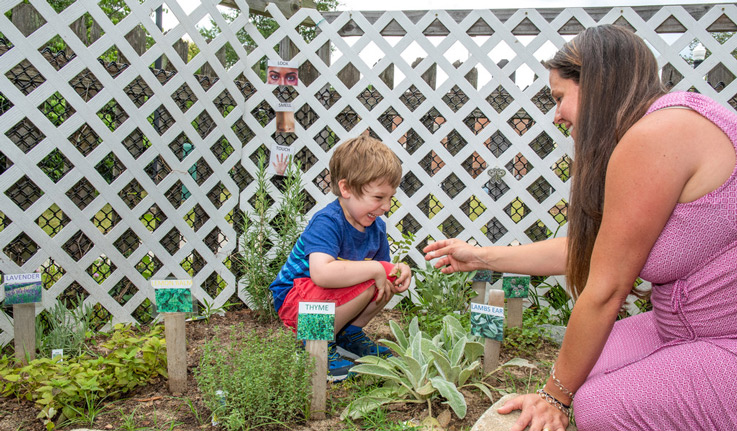UNC Greensboro researchers and child care professionals know that inclusive opportunity for intellectual stimulation begins long before elementary school, and that the best opportunities occur through a multiplicity of sensory experiences that encourage make-believe.
This knowledge is the source of a project recently completed by Kathy Spivey, a teacher at UNCG’s Child Care Education Program and a master’s student in UNCG’s Birth through Kindergarten Interdisciplinary Studies in Education and Development Program, offered jointly through the Department of Specialized Education Services in the School of Education and the Department of Human Development and Family Studies in the School of Health and Human Sciences.
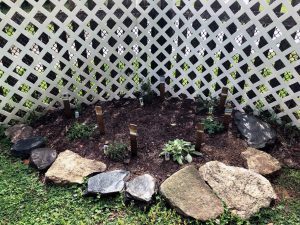
With the understanding that outdoor play reduces stress and increases confidence in young children, Spivey developed a plan to enhance the outdoor area at UNCG’s child care center by building a sensory garden that would give children more opportunities to create and lead their own play.
“Sensory gardens are known to help children with and without disabilities with tactile stimulation, improving sensory integration and processing skills,” Spivey observed in her proposal. She intended for the garden to be accessible to children with differing abilities, and it would be her capstone project for her internship in inclusive early education, which was to reflect leadership and contribution to community.
In planning and constructing the sensory garden, Spivey not only worked with her advisor Dr. Linda Hestenes and her internship professor, Dr. Susan Kingsley, but also Dr. Judy Kinney in the Department of Community and Therapeutic Recreation, director of UNCG’s Child Care Education Program Dr. Sharon Mims, the grounds crew from UNCG Facilities, cross-campus partners Beyond Academics and the very families whose children would eventually play in the garden, and, perhaps most importantly, the children themselves.
“The most unexpected and important partners I had throughout the process were the children,” said Spivey. “The children were excited to participate in each step. They showed enthusiasm as things were in progress and completed, and they especially encouraged me with their kind words and excitement as we accomplished each milestone together.”
Spivey issued surveys to the families about their children’s outdoor play and what they would like to see on a playground. Spivey also planned work days during which families and children participated, as well as volunteers from Beyond Academics, and undergraduate therapeutic recreation student Norma Rodriguez, who focused her senior honors project on her work on the sensory garden.
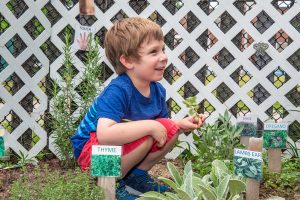
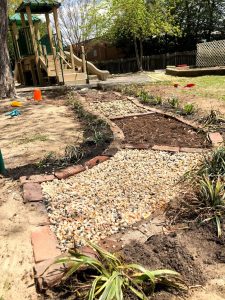
Spivey also created an evaluation tool – a quantitative playground assessment using the Best Practice Indicators and the Preschool Outdoor Environment Measurement Scale. With her team of volunteers, Spivey constructed three sensory pathways, sun catchers, a mud kitchen and a unique music wall made of donated pots and pans. Children were invited to select the plants that would grow alongside safe herbs – labeled with pictures to help them more easily begin to identify them.
“Including children in the decisions motivates them to take pride in the space,” explained Spivey.
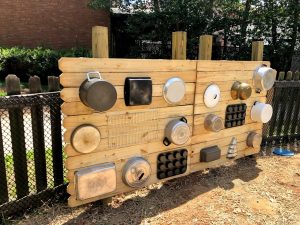
When the children used their new outdoor play-space, multiple teachers noticed that they were more engaged in the play spaces ‒ using their senses to explore, describing their learning in expressive language and requiring less redirection. The enhancements also revitalized the children’s interest in pre-existing structures, such as the stage near the music wall. Spivey also noticed that children who didn’t typically play together were doing so, with new camaraderie through their enjoyment of the space.
“They’re excited to walk along the pathways, and to feel and smell the herbs. Some are interested in collecting rocks to add to the pathways. Many love to “cook” in the mud kitchen and play music with their friends at the music wall,” said Spivey.
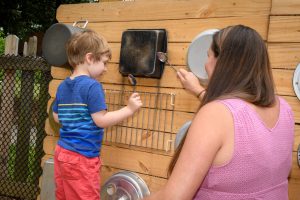
“Kathy clearly understands that children learn through all their senses, and by creating these new outdoor settings she is opening up the opportunity for higher levels of learning,” said Hestenes, a researcher who studies outdoor learning environments for young children. “I am thrilled that she has taken the knowledge and skills she has acquired from her master’s degree program at UNCG and transformed it into a project that is directly impacting our youngest Spartans.”
